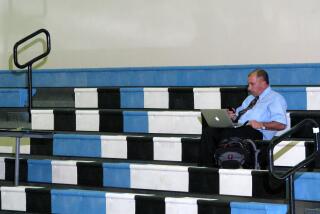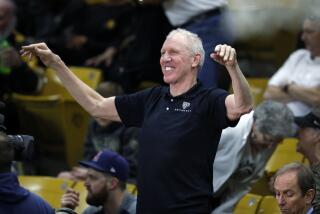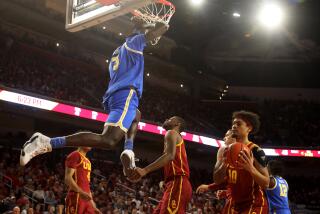Which Walsh Is Staying and Which Is Leaving?
HARTFORD, Conn. — This was the weekend you reluctantly turned down the invitation from the Mount Everest Triathlon to stay at home and compete in your own audio-visual ultra-marathon.
Thanks to remote control, a bionic thumb and, of course, extremely limited amounts of liquid refreshment, you watched all or part of 12 football games over a 60-hour holiday weekend.
But seeing was not always believing. Were Dave Krieg and the Seattle Seahawks NFL or Yankee Conference? Should Troy Aikman be inducted into the NFL’s Hall of Fame this summer, or be made to play an exhibition game first?
If you lined up every serviceman who waved his arms for semaphore’s sake in the last 50 years and multiplied by 10, would it equal half the arm-waving of the Miami Hurricanes? Hey, would you guys prefer to be called the Windmills?
And what about Walshgate? Both Walshes have really good jobs, yet both are rumored to be staying and leaving at the same time and both keep issuing non-denial denials.
Are they the same person, the product of a brilliant makeup artist? Why not a switcheroo? If Steve Walsh coached the San Francisco 49ers and Bill Walsh quarterbacked Miami, who’d win? Or care?
Have you seen Bill Walsh? Has he always been freeze-dried? Or does it just look that way on TV because he was standing in fog at Soldier Field?
He wasn’t? That’s next Sunday? Sorry, folks. You run a 60-hour, 12-game football marathon, you get a little confused.
But on this, the fourth day of the New Year, things are becoming clear. The NFL season isn’t quite over, but the college football season seems to be, now that Notre Dame has turned down Miami’s invitation for an unofficiated, come-as-you-are rematch on an abandoned oil rig in the Straits of Hormuz.
Miami Coach Jimmy “Pile It On” Johnson thinks his team got gypped out of the No. 1 ranking because it had an apparent touchdown nullified and later attempted (and missed) a two-point conversion in its 31-30 loss to Notre Dame last October in South Bend, Ind.
That’s just as well. Despite reports that the Miami program is attempting to erase its image as class-cutting, trash-talking, street-fighting men who live as if above the law, how can you take seriously any school whose students’ main goal is a suntan?
Notre Dame, on the other hand, is a No. 1 the world can respect. Unlike virtually every other big-time football power, Notre Dame has intentionally avoided steps that would further separate its players from the student body.
At Notre Dame, there is no jock dorm. Football players live in regular dorms with the other students. Even share rooms with non-jock students. I’ll never forget going to South Bend nearly 10 years ago to interview Notre Dame tailback and Heisman hopeful Vagas Ferguson and feeling somewhat strange as his friends on his hall, itty-bitty and average-sized Notre Dame students, stopped by to say hi.
At most other schools, you go to interview a football player, you’re surrounded only by other meat hooks. Not at Notre Dame.
Redshirting, the rampant practice of holding a player (usually a freshman) out of competition for a year, is also done at most football factories. Often, there’s nothing physically wrong with the player, other than that there’s somebody better playing ahead of him at his position. He’s redshirted so his body can further mature and grow while he awaits his chance. Of West Virginia’s five starting interior offensive linemen in the Fiesta Bowl -- average size 6-foot-3, 271 pounds -- all were redshirted, fifth-year seniors.
Not at Notre Dame. At Notre Dame, a player is redshirted and becomes a five-year campus man only if he can’t play that season because of serious injury. Otherwise, he is expected to play, to study and to graduate. Since 1965, only seven Notre Dame football players have failed to graduate, a 98.7 percent rate. That’s admirable by any standard.
Like Jane Fonda or Morton Downey Jr., Notre Dame is not something many people feel neutral about. As the most famous Catholic school in the country, its wonderful fight song standard fare for every marching band, its gridiron heroes immortalized on the silver screen (by future presidents, no less), Notre Dame will always suffer backlash.
Critics say if Notre Dame doesn’t cheat, or cheats less than other big-time football programs, it’s only because its national name is so glorious, its allure so magical, that it doesn’t have to.
Even with a poor schnook such as Gerry Faust running the program into the ground, Notre Dame got great recruits. But then, so do UCLA, USC, Nebraska, Oklahoma, Michigan, Auburn and Alabama. For every kid who wants to play at Notre Dame, there’s a kid who wants to beat them.
But if you’re going to beat Notre Dame -- the Irish lose few top players to graduation this year and figure to be even better next season -- you better get lots of kids. That’s what makes college basketball inherently more interesting than college football -- so many more teams have a chance to be in the top 20, if not No. 1.
Over the holidays, Alaska-Anchorage beat mighty Michigan in basketball. That could never happen in football -- even if Alaska-Anchorage had a team.
In college basketball, you can land two or three blue-chip recruits and have a great team. In college football, you have to land 20 or 30, which is why it’s so much harder to turn a college football program from also-ran to all-star.
If three bright blue-chip basketball players chose Harvard, Harvard could go to the Final Four. That could never happen in today’s big-time college football.
But what has happened is Notre Dame, with its great name, and a great coach in Lou Holtz, is No. 1 for the first time in 11 years. And to the extent that people use No. 1 as a guiding light, Notre Dame is not a bad one to have.
More to Read
Go beyond the scoreboard
Get the latest on L.A.'s teams in the daily Sports Report newsletter.
You may occasionally receive promotional content from the Los Angeles Times.










